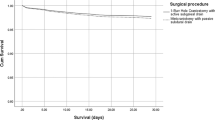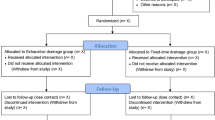Abstract
Background
Burr hole trepanation (BHT) is the most commonly used surgical method for the treatment of chronic subdural haematoma (cSDH).
Method
We give a brief overview on the indication for surgical treatment of cSDH, the surgical technique of BHT, and specific perioperative considerations. In particular, we emphasise on the technique of a subperiosteal drain placement.
Conclusion
BHT is a valid option to treat chronic subdural haematoma. Careful surgical technique and placement of a subperiosteal drain is required to minimise complications and improve outcome.

Similar content being viewed by others

References
Kamenova M, Lutz K, Schaedelin S, Fandino J, Mariani L, Soleman J (2016) Does early resumption of low-dose aspirin after evacuation of chronic subdural hematoma with burr-hole drainage Lead to higher recurrence rates? Neurosurgery 79(5):715–721
Licci M, Kamenova M, Guzman R, Mariani L, Soleman J (2018) Influence of postoperative thrombosis prophylaxis on the recurrence of chronic subdural hematoma after burr-hole drainage. Crit Care Med 46(1):e26–e32
Poon MTC, Al-Shahi Salman R (2018) Association between antithrombotic drug use before chronic subdural haematoma and outcome after drainage: a systematic review and meta-analysis. Neurosurg Rev 41(2):439–445
Santarius T, Kirkpatrick PJ, Ganesan D et al (2009) Use of drains versus no drains after burr-hole evacuation of chronic subdural haematoma: a randomised controlled trial. Lancet 374(9695):1067–1073
Santarius T, Kirkpatrick PJ, Kolias AG, Hutchinson PJ (2010) Working toward rational and evidence-based treatment of chronic subdural hematoma. Clin Neurosurg 57:112–122
Soleman J, Lutz K, Schaedelin S, Kamenova M, Guzman R, Mariani L, Fandino J (2019) Subperiosteal vs subdural drain after burr-hole drainage of chronic subdural hematoma: a randomized clinical trial (cSDH-drain-trial). Neurosurgery 85(5):E825–E834
Soleman J, Nocera F, Mariani L (2017) The conservative and pharmacological management of chronic subdural haematoma. Swiss Med Wkly 147:w14398
Unterhofer C, Freyschlag CF, Thomé C, Ortler M (2016) Opening the internal hematoma membrane does not alter the recurrence rate of chronic subdural hematomas: a prospective randomized trial. World Neurosurg 92:31–36
Weigel R (2003) Outcome of contemporary surgery for chronic subdural haematoma: evidence based review. J Neurol Neurosurg Psychiatry 74(7):937–943
Author information
Authors and Affiliations
Corresponding authors
Ethics declarations
Conflict of interest
The authors declare that they have no conflict of interest.
Additional information
Key points
- BHT is considered, to date, the gold standard surgical technique for drainage of cSDH.
- BHT of cSDH is indicated in symptomatic patients or haematomas leading to a significant space-occupying effect.
- The insertion of a drain after BHT of cSDH significantly reduces the recurrence rate.
- The insertion of a SPD should be encouraged.
- After haematoma irrigation, the cortex surface should be visible; otherwise, membranes need to be carefully perforated.
- Avoid wide opening or removal of membranes, due to the risk of seizures.
- The SPD is placed over both burr holes, without sealing them off, in order to allow communication between the subdural space and the SPD.
- The parietal wound should be closed first, to allow continuous irrigation frontally, preventing pneumocephalus.
- The passive SPD is left in situ for 48 h, and the patients should be kept in a flat position.
- Postoperative CT scans are not routinely performed, and thrombosis prophylaxis is administered on the first postoperative day.
Publisher’s note
Springer Nature remains neutral with regard to jurisdictional claims in published maps and institutional affiliations.
This article is part of the Topical Collection on Neurosurgery general
Electronic supplementary material
Video showing the drainage of a right-sided chronic subdural haematoma by double burr hole trepanation and the stepwise insertion of a subperiosteal drain (MP4 281,130 kb)
Rights and permissions
About this article
Cite this article
Ebel, F., Guzman, R. & Soleman, J. Burr hole trepanation and insertion of a subperiosteal drain for chronic subdural haematoma: how I do it. Acta Neurochir 162, 2707–2710 (2020). https://doi.org/10.1007/s00701-020-04442-2
Received:
Accepted:
Published:
Issue Date:
DOI: https://doi.org/10.1007/s00701-020-04442-2



